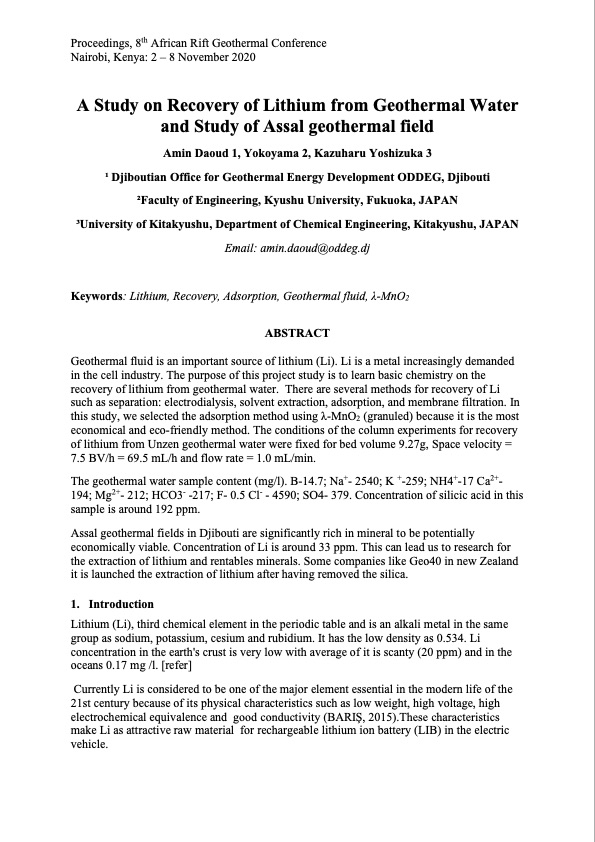
PDF Publication Title:
Text from PDF Page: 001
Proceedings, 8th African Rift Geothermal Conference Nairobi, Kenya: 2 – 8 November 2020 A Study on Recovery of Lithium from Geothermal Water and Study of Assal geothermal field Amin Daoud 1, Yokoyama 2, Kazuharu Yoshizuka 3 1 Djiboutian Office for Geothermal Energy Development ODDEG, Djibouti 2Faculty of Engineering, Kyushu University, Fukuoka, JAPAN 3University of Kitakyushu, Department of Chemical Engineering, Kitakyushu, JAPAN Email: amin.daoud@oddeg.dj Keywords: Lithium, Recovery, Adsorption, Geothermal fluid, λ-MnO2 ABSTRACT Geothermal fluid is an important source of lithium (Li). Li is a metal increasingly demanded in the cell industry. The purpose of this project study is to learn basic chemistry on the recovery of lithium from geothermal water. There are several methods for recovery of Li such as separation: electrodialysis, solvent extraction, adsorption, and membrane filtration. In this study, we selected the adsorption method using λ-MnO2 (granuled) because it is the most economical and eco-friendly method. The conditions of the column experiments for recovery of lithium from Unzen geothermal water were fixed for bed volume 9.27g, Space velocity = 7.5 BV/h = 69.5 mL/h and flow rate = 1.0 mL/min. The geothermal water sample content (mg/l). B-14.7; Na+- 2540; K +-259; NH4+-17 Ca2+- 194; Mg2+- 212; HCO3- -217; F- 0.5 Cl- - 4590; SO4- 379. Concentration of silicic acid in this sample is around 192 ppm. Assal geothermal fields in Djibouti are significantly rich in mineral to be potentially economically viable. Concentration of Li is around 33 ppm. This can lead us to research for the extraction of lithium and rentables minerals. Some companies like Geo40 in new Zealand it is launched the extraction of lithium after having removed the silica. 1. Introduction Lithium (Li), third chemical element in the periodic table and is an alkali metal in the same group as sodium, potassium, cesium and rubidium. It has the low density as 0.534. Li concentration in the earth's crust is very low with average of it is scanty (20 ppm) and in the oceans 0.17 mg /l. [refer] Currently Li is considered to be one of the major element essential in the modern life of the 21st century because of its physical characteristics such as low weight, high voltage, high electrochemical equivalence and good conductivity (BARIŞ, 2015).These characteristics make Li as attractive raw material for rechargeable lithium ion battery (LIB) in the electric vehicle.PDF Image | Recovery of Lithium from Geothermal Water

PDF Search Title:
Recovery of Lithium from Geothermal WaterOriginal File Name Searched:
Daoud, Yoshizuka - 2020 - A Study on Recovery of Lithium from Geothermal Water and Study of Assal geothermal field.pdfDIY PDF Search: Google It | Yahoo | Bing
Product and Development Focus for Infinity Turbine
ORC Waste Heat Turbine and ORC System Build Plans: All turbine plans are $10,000 each. This allows you to build a system and then consider licensing for production after you have completed and tested a unit.Redox Flow Battery Technology: With the advent of the new USA tax credits for producing and selling batteries ($35/kW) we are focussing on a simple flow battery using shipping containers as the modular electrolyte storage units with tax credits up to $140,000 per system. Our main focus is on the salt battery. This battery can be used for both thermal and electrical storage applications. We call it the Cogeneration Battery or Cogen Battery. One project is converting salt (brine) based water conditioners to simultaneously produce power. In addition, there are many opportunities to extract Lithium from brine (salt lakes, groundwater, and producer water).Salt water or brine are huge sources for lithium. Most of the worlds lithium is acquired from a brine source. It's even in seawater in a low concentration. Brine is also a byproduct of huge powerplants, which can now use that as an electrolyte and a huge flow battery (which allows storage at the source).We welcome any business and equipment inquiries, as well as licensing our turbines for manufacturing.| CONTACT TEL: 608-238-6001 Email: greg@infinityturbine.com | RSS | AMP |